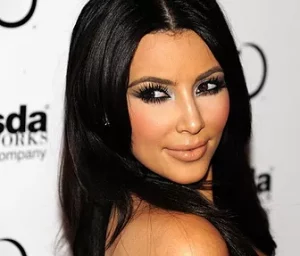LASH HISTORY
Welcome to a fascinating history class!
The long and sometimes weird history of long eyelashes.
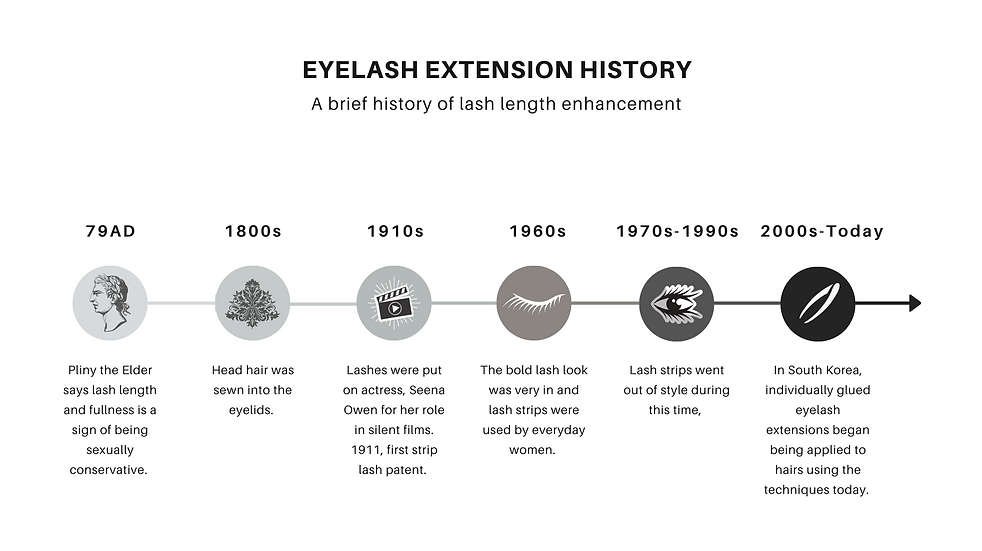
Select through the tabs below to view a different era
#1 ANCIENT ROME
#2 The 1800s
#3 1910s
#4 1920s and 1930s
#5 1940s and 1950s
#6 1950s and 1960s
#7 1970s and 1980s
#8 1990s
#9 Early 2000s
#10 2010's
#1 ANCIENT ROME
Ancient Rome
 To understand why fake eyelashes were even created, we must first break down why long lashes were seen as an alluring feature in the first place.
At its core, this obsession with longer lashes stems from the idea that lashes get shorter with age. In ancient Rome (about 79 A.D), author Pliny the Elder helped make long lashes even more enviable when he implied they were linked to being chaste.
“Eyelashes fell out from excessive sex, and so it was especially important for women to keep their eyelashes long to prove their chastity,” Pliny claimed, incorrectly of course. As a result, women strived to have the longest lashes possible.
Click the next tab (#2) located above to move to the next era...
To understand why fake eyelashes were even created, we must first break down why long lashes were seen as an alluring feature in the first place.
At its core, this obsession with longer lashes stems from the idea that lashes get shorter with age. In ancient Rome (about 79 A.D), author Pliny the Elder helped make long lashes even more enviable when he implied they were linked to being chaste.
“Eyelashes fell out from excessive sex, and so it was especially important for women to keep their eyelashes long to prove their chastity,” Pliny claimed, incorrectly of course. As a result, women strived to have the longest lashes possible.
Click the next tab (#2) located above to move to the next era...
#2 The 1800s
They did what?
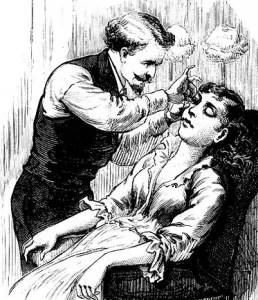
In the 1800s, almost two thousand years after Pliny made that assertion, lashes came into favor again — and this time, sh-t got real. In 1899, for instance, there were accounts of women having lashes sewen into their eyelids via needles. And yes, it was a popular procedure, even in capitals like Paris.
Around this time, the more faint of heart attempted to glue human hair to their eyelids instead of threading it, but the method wasn’t too successful and the hair often fell off.If only they’d known that in 20 years or so, they’d get some of the lash innovation they really needed.
#3 1910s
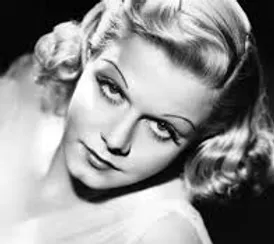 There’s a bit of a disagreement over who really created the kind of false eyelashes we know and love today.
In 1911, a Canadian woman named Anna Taylor first patented artificial lashes, using a crescent of fabric implanted with itty bitty hairs.
In 1915, Karl Nessler, a hairdresser known for his permanent waves, opened a hair salon in New York and sold lash services, promoting false eyelashes at his salon as, according to the New York Times, “a guard against the glare of electric lights.” He also hired chorus girls to sell them and bat their lashes at customers.
But it wasn’t until 1916 when falsies started to become truly popular, and it was all because of a picky Hollywood director. D. W. Griffith was filming Intolerance with actress Seena Owen when he took one look at her in Babylonian attire and thought, “Something is not right.”
Reportedly, Griffith wanted Owen’s eyelashes to be “supernatural” and practically “brushing her cheeks,” so he ordered the film’s wigmaker to glue lashes made of human hair onto Owen’s own eyelids using spirit gum. Of course, this kind of ended in disaster, with Intolerance costar Lillian Gish writing in her memoir: “One morning she arrived at the studio with her eyes swollen nearly shut. Fortunately, Mr. Griffith had already shot the important scenes.”
In other words, the technology wasn’t exactly great. Click here to watch Seena Owen in the film.
There’s a bit of a disagreement over who really created the kind of false eyelashes we know and love today.
In 1911, a Canadian woman named Anna Taylor first patented artificial lashes, using a crescent of fabric implanted with itty bitty hairs.
In 1915, Karl Nessler, a hairdresser known for his permanent waves, opened a hair salon in New York and sold lash services, promoting false eyelashes at his salon as, according to the New York Times, “a guard against the glare of electric lights.” He also hired chorus girls to sell them and bat their lashes at customers.
But it wasn’t until 1916 when falsies started to become truly popular, and it was all because of a picky Hollywood director. D. W. Griffith was filming Intolerance with actress Seena Owen when he took one look at her in Babylonian attire and thought, “Something is not right.”
Reportedly, Griffith wanted Owen’s eyelashes to be “supernatural” and practically “brushing her cheeks,” so he ordered the film’s wigmaker to glue lashes made of human hair onto Owen’s own eyelids using spirit gum. Of course, this kind of ended in disaster, with Intolerance costar Lillian Gish writing in her memoir: “One morning she arrived at the studio with her eyes swollen nearly shut. Fortunately, Mr. Griffith had already shot the important scenes.”
In other words, the technology wasn’t exactly great. Click here to watch Seena Owen in the film.
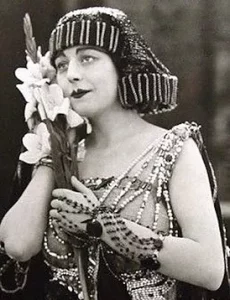
#4 1920s and 1930s
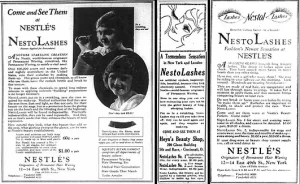 “When a fair young thing looks at you mistily through her long, curling lashes, do not fall for it until you investigate,” a columnist wrote in 1921, according to the Times. “The long, curling eyelashes may not be hers, except by right of purchase.
”You’d think, just by reading that, that false eyelashes were some kind of Venus flytrap or torture device. Plenty of people were still skeptical of false eyelashes in the 1920s, but it was a different story among the fashionistas.
Through the 1930s, Vogue gave them their stamp of approval with ads featuring more artful fake lashes, some laden with gold and platinum beads, Racked reported.
“When a fair young thing looks at you mistily through her long, curling lashes, do not fall for it until you investigate,” a columnist wrote in 1921, according to the Times. “The long, curling eyelashes may not be hers, except by right of purchase.
”You’d think, just by reading that, that false eyelashes were some kind of Venus flytrap or torture device. Plenty of people were still skeptical of false eyelashes in the 1920s, but it was a different story among the fashionistas.
Through the 1930s, Vogue gave them their stamp of approval with ads featuring more artful fake lashes, some laden with gold and platinum beads, Racked reported.


#5 1940s and 1950s
Hollywood starlets embrace the big lash...
Quite naturally, Hollywood starlets in the 1940s and ’50s loved a good fake eyelash, with women like Marilyn Monroe and Rita Hayworth wearing them in photoshoots to make their eyes look larger and more, well, eye-catching. What made them a generally better product in the 1950s was the introduction of plastic materials fit for fake eyelashes. No longer were lashes made of human hair and/or fabric, but durable thin plastic — which is how some are still manufactured today. Click here to watch a fascinating 1949 factory video showing how they made the strip lashes.
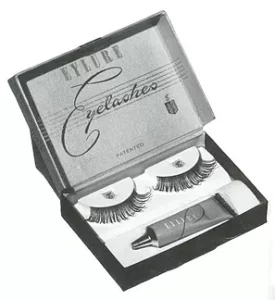
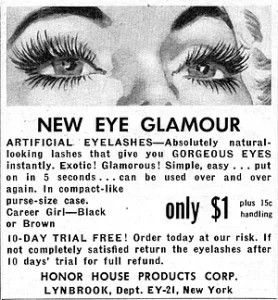
#6 1950s and 1960s
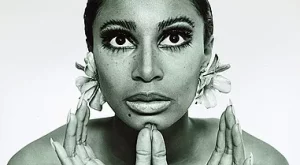
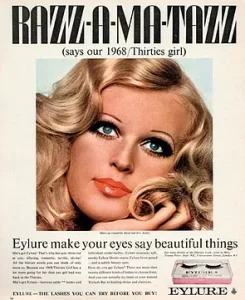 While the 1940s and ’50s were all about glamour, the 1960s makeup aesthetic was more adventurous, innovative and young.
One person at the center of this movement, of course, was the model Twiggy, whose signature look included large lashes that accentuated her already prominent eyes. Though the most iconic images of Twiggy showed her with lashes painted directly onto her face, she wore plenty of fake eyelashes, too.
Other models at the time followed Twiggy’s lead, like Jean Shrimpton and Penelope Tree, who frequently appeared in the pages of Vogue and Harper’s Bazaar, showing women across the globe just how extreme their beauty looks could be.
While the 1940s and ’50s were all about glamour, the 1960s makeup aesthetic was more adventurous, innovative and young.
One person at the center of this movement, of course, was the model Twiggy, whose signature look included large lashes that accentuated her already prominent eyes. Though the most iconic images of Twiggy showed her with lashes painted directly onto her face, she wore plenty of fake eyelashes, too.
Other models at the time followed Twiggy’s lead, like Jean Shrimpton and Penelope Tree, who frequently appeared in the pages of Vogue and Harper’s Bazaar, showing women across the globe just how extreme their beauty looks could be.

#7 1970s and 1980s
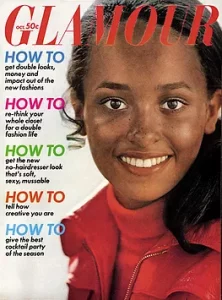 There’s no real explanation for this — other than that fads come and go — but the 1970s and ’80s weren’t major decades for false eyelashes. The makeup of the 1970s was much more muted and natural, and in the 1980s, things like blush and dark lipstick were more popular than massive lashes.
Some women, like Cher, did continue to wear them, as she would.
Mascara was more popular at that time. Click here to watch 1980-1984 Mabelline commercials.
There’s no real explanation for this — other than that fads come and go — but the 1970s and ’80s weren’t major decades for false eyelashes. The makeup of the 1970s was much more muted and natural, and in the 1980s, things like blush and dark lipstick were more popular than massive lashes.
Some women, like Cher, did continue to wear them, as she would.
Mascara was more popular at that time. Click here to watch 1980-1984 Mabelline commercials.
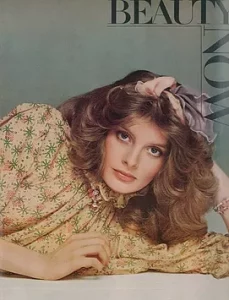
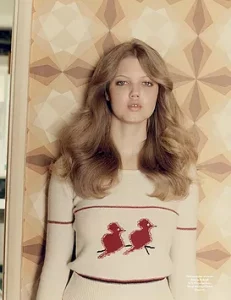
#8 1990s
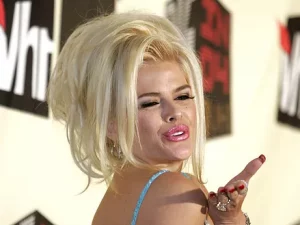 Starting in the 1990s, fake eyelashes roared back into popularity. For women like Anna Nicole Smith, Pamela Anderson and model Cindy Crawford, eyelashes were an easy way to achieve a sort of retro/bombshell 1950s glamour with, quite literally, the blink of an eye.
Starting in the 1990s, fake eyelashes roared back into popularity. For women like Anna Nicole Smith, Pamela Anderson and model Cindy Crawford, eyelashes were an easy way to achieve a sort of retro/bombshell 1950s glamour with, quite literally, the blink of an eye.
#9 Early 2000s
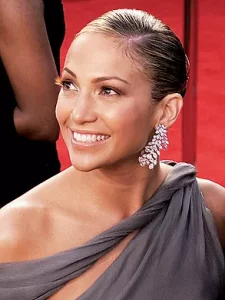 The method of application we use today started in South Korea and then spread throughout the globe.
In the 2000s, fake eyelashes got a very fancy — and very expensive — makeover. Jennifer Lopez wore fake eyelashes made of red fox fur to the 2001 Academy Awards; in 2004, Madonna started wearing a $10,000 pair of real mink and diamond lashes to promote her Re-Invention tour.
You'll learn more about the very sad real mink lash industry in the product section of this training.
The method of application we use today started in South Korea and then spread throughout the globe.
In the 2000s, fake eyelashes got a very fancy — and very expensive — makeover. Jennifer Lopez wore fake eyelashes made of red fox fur to the 2001 Academy Awards; in 2004, Madonna started wearing a $10,000 pair of real mink and diamond lashes to promote her Re-Invention tour.
You'll learn more about the very sad real mink lash industry in the product section of this training.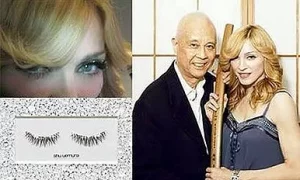
#10 2010's
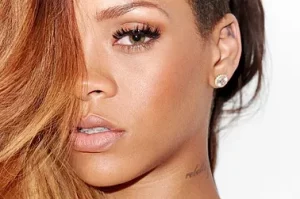 Real mink fur began going out of style due to ethical concerns being raised about the treatment of the animals that the fur was coming from, in addition to the desired look changed. Clients wanted curly black lashes and real mink lashes cannot hold a curl and are not black.
Today, synthetic mink made of PBT (same material as toothbrush bristles) is the most commonly used lash extension material.
Additionally, volume and mega volume lash extensions gained popularity around 2015. Expanding the possibilities of looks.
Real mink fur began going out of style due to ethical concerns being raised about the treatment of the animals that the fur was coming from, in addition to the desired look changed. Clients wanted curly black lashes and real mink lashes cannot hold a curl and are not black.
Today, synthetic mink made of PBT (same material as toothbrush bristles) is the most commonly used lash extension material.
Additionally, volume and mega volume lash extensions gained popularity around 2015. Expanding the possibilities of looks.